Space Tech Statistics By Trend, Market Share, Revenue, Investors, Regions and Recent Developments (2025)
Updated · Oct 14, 2025

Table of Contents
- Introduction
- Editor’s Choice
- General Statistics
- Space Tech Trend Analysis
- Factors Influencing the Market of Space Tech
- Space Tech Market Statistics
- Space Tech Revenue Statistics
- Funding For Space Tech Startups Statistics
- Space Tech Funding Statistics by Region
- Top Investors
- Space Tech Sectors by Number of Companies
- Space Tech Company Distribution by Country
- Recent Developments
- Conclusion
Introduction
Space Tech Statistics: Space technology is a technology that uses tools and machines used in traveling or other activities beyond the Earth’s atmosphere. It covers rockets, satellites, stations, spacecraft, space communication, propulsion systems, and other equipment that help in building and supporting space missions.
It helps with navigation, weather updates, global connections, exploration, clean energy research, and future human life in space, boosting progress worldwide. Both startups and well-known organizations are taking bold steps, while fresh investments and collaborations are opening the door to even more possibilities. Space Tech Statistics, detailed below, will give a clear view of how space technology is growing and making an impact around the world.
Editor’s Choice
- A report published by Precedence Research analysis, the global space technology industry is projected to be valued at USD 512.08 billion by 2025.
- As of 2024, space vehicles led the segment with USD 315.63 billion in revenue, followed by orbital launch vehicles at USD 59.29 billion.
- Space Tech Statistics shows that in 2024, North America held the highest share of 55.84%, followed by Europe with 20.64%.
- Besides, government programs made the largest share of space technology revenue, reaching about USD 326.07 billion.
- As of 2024, the U.S. space technology industry was valued at USD 237.62 billion and is expected to reach up to USD 254.18 billion by 2025.
- According to StartUs Insights analysis, the space technology industry continues to expand at a steady pace, recording an annual growth rate of 0.44%.
- Mordor Intelligence report states that in 2025, the U.S. Space Force kept its budget steady at USD 29.4 billion.
- amadeuscapital.com further shows that in 2024, the space technology market showed strong performance, in which the ground segment generated USD 155.3 billion in revenue.
- startus-insights.com also shows that Fidelity Investments stands out with USD 957.4 million directed into four companies.
- In 2025, the global SpaceTech ecosystem shows a diverse distribution of companies across different sectors, in which Satellite Communication leads with 535 companies.
- By 2025, North America will have the highest number of SpaceTech companies, with over 6,477 firms in the industry.
- In 2025, funding in the SpaceTech sector is heavily concentrated in North America, which secures the majority share at 61.7%, based on the reports of spacetech.global.
General Statistics
- According to StartUs Insights analysis, the space technology industry continues to expand at a steady pace, recording an annual growth rate of 0.44%.
- More than 35,000 companies are active in this field, while the global space economy is forecast to touch USD 1.8 trillion by 2035.
- The workforce is also strong, with over 3.5 million employees, and nearly 184,000 new jobs were created in the past year.
- Innovation is evident, as the sector holds more than 60,000 patents and has secured over 10,000 research grants.
- Major hubs of activity can be found in the United States, the United Kingdom, India, Germany, and Canada.
- The investment landscape remains vibrant, averaging around USD 61.5 million per funding round, supported by over 3,700 investors and affecting more than 4,700 companies.
- Collectively, firms such as Fidelity, Geely, and BlackRock have poured over USD 4 billion into the market.
- Looking ahead, the FAA may approve up to 25 SpaceX Starship launches in 2025, while the European Space Agency plans orbital test flights of its Space Rider spaceplane in the third quarter of the same year.
- Promising startups include HEX20, Yuri, Rebel Space Technologies, Novart Space Technologies, and Re CAE.
- Mordor Intelligence report states that in 2025, the U.S. Space Force kept its budget steady at USD 29.4 billion.
- In 2024, China allocated CNY 20 billion (USD 2.8 billion), while Japan launched JPY 1 trillion (USD 6.88 billion).
- Advances in microelectronics and 3D printing cut small satellite costs below USD 200,000, shifting from single builds to fleets.
- Starlink runs 7,556 satellites, generating USD 12.3 billion from 7.6 million users in 2025.
- China launched 270 satellites in 2024, while Project Kuiper targets 54 by mid-2025 toward 3,232.
Space Tech Trend Analysis
| Category | Satellite Monitoring | Space Robotics | Reusable Rockets |
| Growth Rate | 8.04 | 4.15 |
14.25 |
|
Number of Companies |
263 | 163 | 75 |
| Number of Employees | 12,900 | 10,100 |
3,800 |
|
New Hires (2024) |
960 | 760 |
450 |
Factors Influencing the Market of Space Tech
- A report published on mordorintelligence.com states that increased government spending on space programs could raise growth by around 1.8%, while smaller satellite designs enabling large constellations may add 1.2%.
- Rising demand for high-capacity satellite broadband is likely to contribute 1.5%, and the commercialisation of space tourism and in-orbit services could add 0.9%.
- National security priorities may boost growth by 1.1%, and reusable launch vehicles, which lower launch costs, are expected to increase it by about 1.3%.
Space Tech Market Statistics
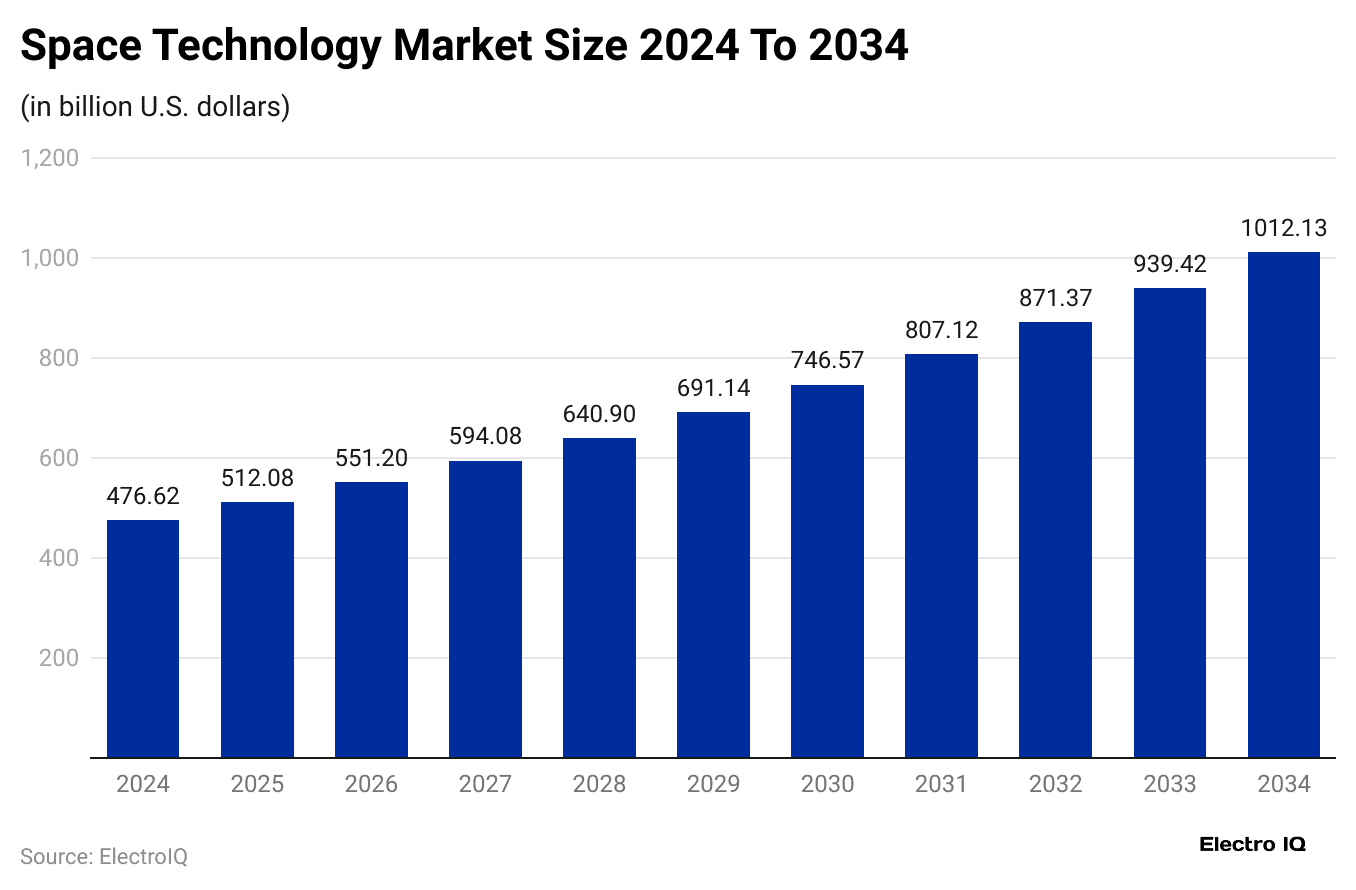
- The global space technology industry is projected to be valued at USD 512.08 billion by 2025.
- Between 2025 and 2034, it is anticipated to grow at a CAGR of 7.86%.
- Furthermore, the market size in the coming years is expected to be USD 551.20 billion (2026), USD 594.08 billion (2027), USD 640.90 billion (2028), USD 691.14 billion (2029), USD 746.57 billion (2030), USD 807.12 billion (2031), USD 871.37 billion (2032), USD 939.42 billion (2033), and USD 1,012.13 billion (2034).
- In 2024, North America held the highest share of 55.84%, while the Asia Pacific is forecast to record the quickest growth of 9.59% CAGR from 2025 to 2034.
- Looking at categories, space vehicles accounted for 70.77% of revenue in 2024.
- Based on usage, commercial activities contributed 68.41%, and in applications, navigation, along with mapping, captured 22.99% of the global total.
By Type
- According to Precedence Research analysis in 2024, space vehicles led the segment with USD 315.63 billion in revenue, followed by orbital launch vehicles at USD 59.29 billion.
- Meanwhile, space stations contributed USD 43.57 billion, while in-space propulsion reached USD 26.65 billion.
- Deep-space communication generated USD 17.35 billion, and other categories together added about USD 14.13 billion.
By Regional Analysis
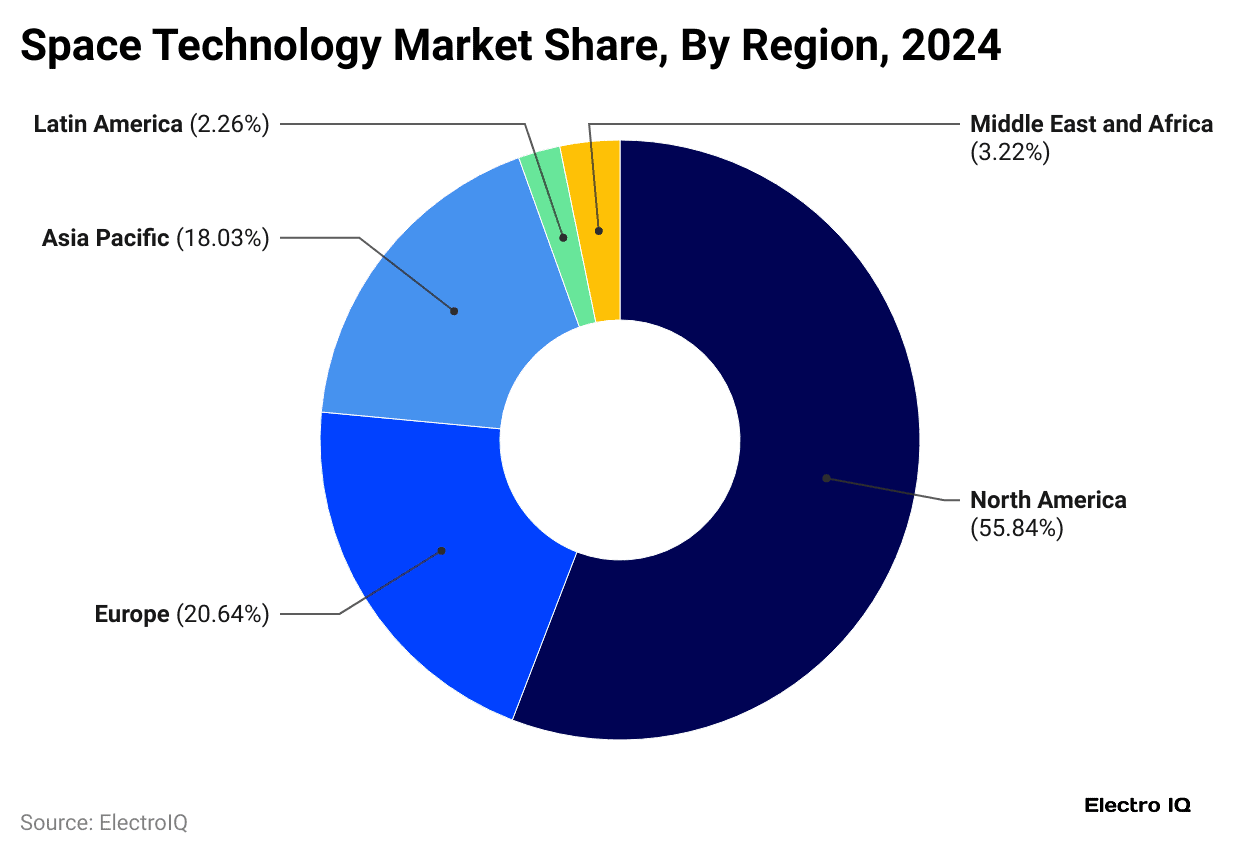
- Space Tech Statistics shows that in 2024, North America held the highest share of 55.84%, followed by Europe with 20.64%.
- Moreover, other regions’ market share in the Space Technology was stated as Asia Pacific (18.03%), the Middle East & Africa (3.22%), and Latin America (2.26%).
By End-Use
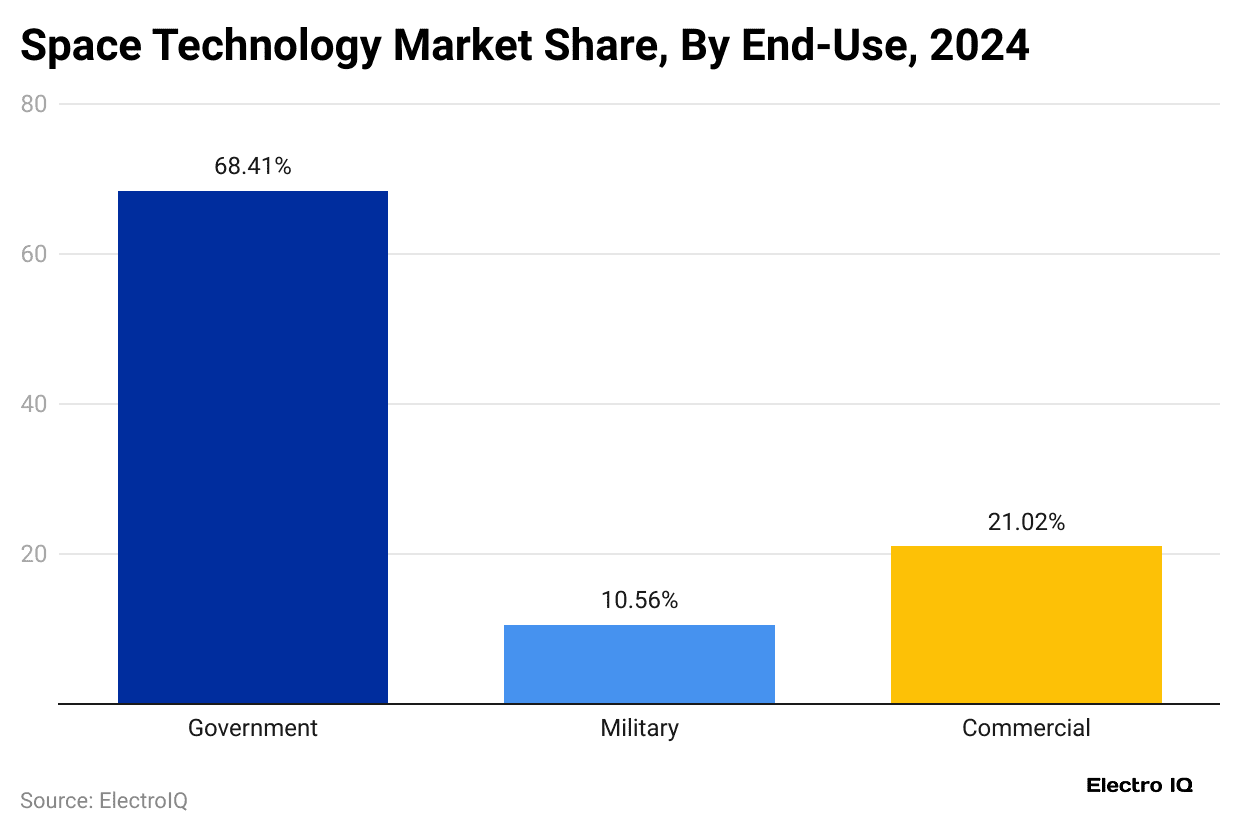
- In 2024, government programs made the largest share of space technology revenue, reaching about USD 326.07 billion.
- In contrast, military applications accounted for revenue of USD 50.34 billion, while commercial uses generated almost USD 100.21 billion.
Space Tech Market Statistics in the United States

- As of 2024, the U.S. space technology industry was valued at USD 237.62 billion and is expected to reach up to USD 254.18 billion by 2025.
- The annual rate of the market is growing at a CAGR of 7.38% between 2025 and 2034.
- Furthermore, the market size in the coming years will reach around USD 272.39 billion by 2026, followed by USD 292.28 billion (2027), USD 313.92 billion (2028), USD 337.02 billion (2029), USD 363.42 billion (2030), USD 390.07 billion (2031), USD 419.23 billion (2032), USD 449.23 billion (2033), and USD 482.58 billion (2034).
Space Tech Revenue Statistics
- amadeuscapital.com further shows that in 2024, the space technology market showed strong performance, in which the ground segment generated USD 155.3 billion in revenue, growing at a 3% CAGR from 2019 to 2024, driven by the widespread use of GNSS chips and direct-to-device terminals.
- Downstream satellite services followed closely with USD 108.3 billion in revenue and a 6% CAGR, supported by demand for broadband, Earth observation (EO) analytics, and mobility links.
- Satellite manufacturing contributed USD 20 billion, also growing at 6%, as mass-produced smallsats and digital payloads gained momentum.
- Launch services reached USD 9.3 billion, posting the fastest growth at 11%, fueled by reusable rockets and rideshare economics.
- On-orbit servicing and sustainability accounted for USD 2.7 billion, likewise growing at 11%, with key drivers including satellite life-extension and debris-removal solutions.
- Meanwhile, return logistics earned revenue below USD 1 billion.
Funding For Space Tech Startups Statistics
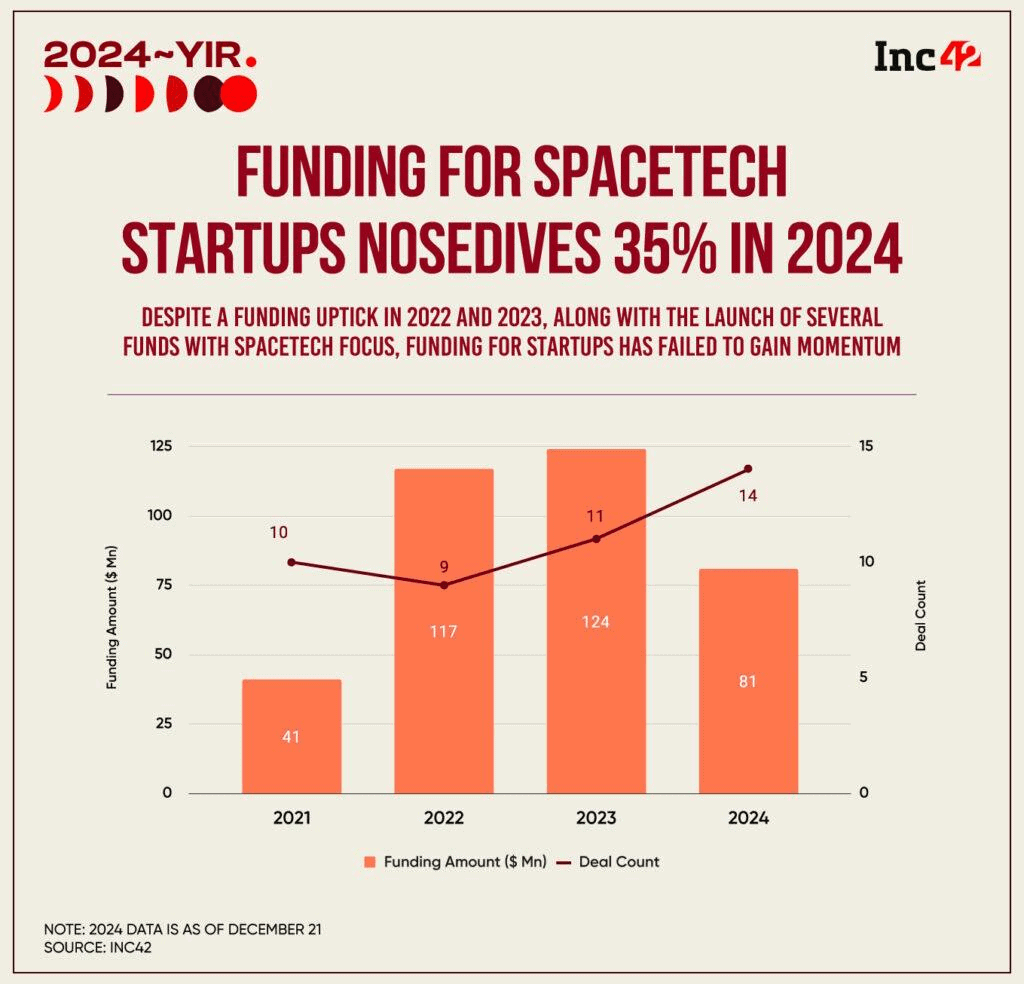
- Inc42’s report published in 2024 shows that funding for Indian space technology startups decreased by 35% from last year, reaching USD 81 million in 2024.
- However, despite the decline in total capital, deal activity increased, moving up from 11 agreements in 2023 to 14 in 2024.
Space Tech Funding Statistics by Region
- According to Spacetech.global, North America leads SpaceTech funding in 2025 with 61.7%, followed by Europe and Central Asia at 23.3% and East Asia & Pacific at 9.7%.
- South Asia makes up 3.6%, the Middle East & North Africa account for 1.4%, and South America stays low at 0.3%.
Top Investors
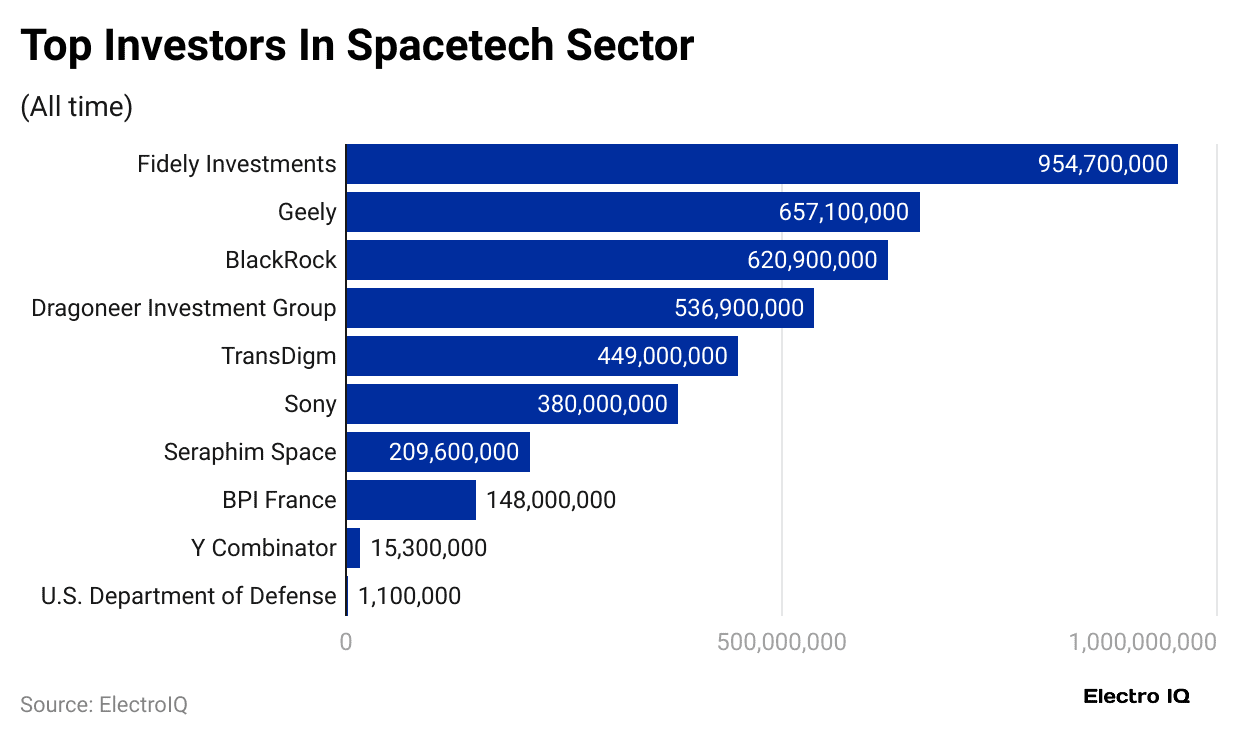
- Fidelity Investments stands out with USD 957.4 million directed into four companies.
- Geely follows with USD 657.1 million in two firms, mainly through GeeSpace, its satellite unit, which launched 11 satellites into low Earth orbit in 2024.
- BlackRock has spread USD 630.9 million across seven companies and led a USD 140 million round for Loft Orbital, a space-infrastructure-as-a-service startup.
- Dragoneer Investment Group has placed USD 536.9 million into two firms, showing a sharp investment focus.
- TransDigm contributed USD 449 million to five companies, while Sony invested USD 380 million in three and also created Sony Space Communications Corporation to run optical space links.
- Seraphim Space put USD 209.6 million into ten firms and in April 2024 launched its second fund, aiming at nearly 30 startups.
- BPI France committed USD 148 million to 12 companies, joining a USD 174 million round for Loft Orbital.
- Y Combinator invested USD 15.3 million in 17 startups, and the U.S. Department of Defence placed USD 1.1 million across 33 firms, later proposing quantum space projects.
Space Tech Sectors by Number of Companies
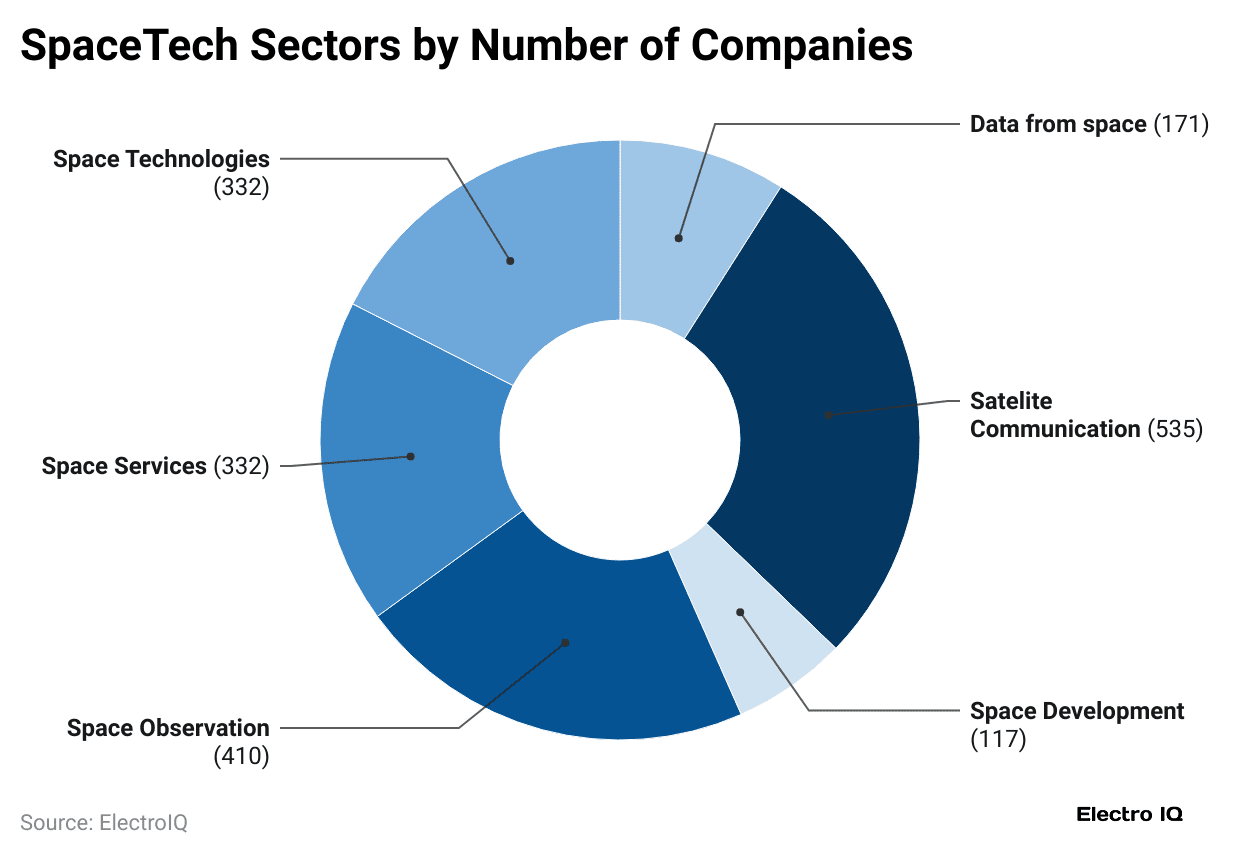
- In 2025, the global SpaceTech ecosystem shows a diverse distribution of companies across different sectors, in which Satellite Communication leads with 535 companies.
- Besides, Space Observation includes 410 companies, while both Space Services and Space Technologies have 332 each.
- The Data from Space sector has 171 companies, and Space Development accounts for 117 companies.
Space Tech Company Distribution by Country
- By 2025, North America will have the highest number of SpaceTech companies, with over 6,477 firms in the industry, followed by the United Kingdom with 742 companies and Canada with 609 companies.
Furthermore, other countries with several companies involved in Space Technology are stated in the table below:
| Country | Number of Companies |
| China | 535 |
| Germany | 465 |
| India | 412 |
| France | 365 |
| Spain | 276 |
| Netherlands | 250 |
| Australia | 216 |
| Japan | 193 |
| Italy | 193 |
| Israel | 154 |
| Singapore | 121 |
| Switzerland | 115 |
| Sweden | 71 |
| Belgium | 54 |
| South Korea | 49 |
| Brazil | 41 |
| Finland | 36 |
| Poland | 33 |
| Ireland | 31 |
| Czech Republic | 27 |
| Estonia | 9 |
| Lithuania | 6 |
Recent Developments
- Early 2025: First soft landing by a commercial company (Blue Ghost Mission 1).
- March 2025: ISRO’s SPADEX undocking & CE20 engine hot test.
- May 17, 2025: LandSpace launches improved methane rocket “Zhuque-2E Y2”.
- July 14 to 15, 2025: China sends supply mission Tianzhou-9 to Tiangong station.
- June 25 to July 15, 2025: Axiom Mission 4 (Axe-4) to ISS
Conclusion
Space technology is now termed as one of the most important space advancements, which provides a bundle of benefits to people everywhere. It can help solve major issues such as climate change and resource use. Working together across countries, focusing on sustainable methods, and putting more effort into research are key steps.
At the same time, opening doors for businesses and encouraging public interest can motivate young people to choose space careers. With ethical and responsible exploration, space technology can truly support society and the Earth.
Sources
FAQ.
This supports daily life by giving GPS, weather updates, internet, TV, and better communication.
The United States leads space technology with NASA’s history, big budgets, and many active satellites.
Space technology is growing enormously, with satellites, new materials, and energy solutions boosting science and the economy.

Maitrayee Dey has a background in Electrical Engineering and has worked in various technical roles before transitioning to writing. Specializing in technology and Artificial Intelligence, she has served as an Academic Research Analyst and Freelance Writer, particularly focusing on education and healthcare in Australia. Maitrayee's lifelong passions for writing and painting led her to pursue a full-time writing career. She is also the creator of a cooking YouTube channel, where she shares her culinary adventures. At Smartphone Thoughts, Maitrayee brings her expertise in technology to provide in-depth smartphone reviews and app-related statistics, making complex topics easy to understand for all readers.










